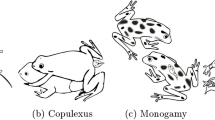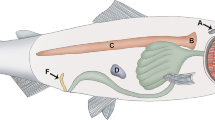Summary
The origin and evolution of the embryonic gonad ofViviparus viviparus were studied ultrastructurally. The gonad is formed by migration and multiplication of pericardial cells.
There are several successive stages during gonad organogenesis: during the sexually undifferentiated stage with one cellular type, the gonad is made up of primordial cells which seem to be identical. The sexually undifferentiated stage with two cell types is characterized by the differentiation of germinal and non-germinal cells. The non-germinal cells are linked to one another by septate junctions and their long extensions completely surround the germinal cells which remain isolated and do not form junctions with their neighbours. The gonad sexualisation does not appear until after organogenesis, towards the end of embryonic development, or even after birth.
Résumé
L'origine et l'évolution de la gonade embryonnaire deViviparus viviparus sont étudiées ultrastructuralement. La gonade se forme par migration et multiplication de cellules péricardiques.
Plusieurs étapes se succèdent au cours de l'organogenèse gonadique: durant le stade sexuellement indifférencié à un seul type cellulaire, la gonade est constituée de cellules-souches qui paraissent toutes identiques. Le stade suivant ou stade sexuellement indifférencié à deux types cellulaires est caractérisé par la différenciation de cellules germinales et de cellules non germinales. Les cellules non germinales sont ancrées les unes aux autres par des jonctions septées et leurs longs prolongements enveloppent totalement les cellules germinales qui demeurent isolées et n'établissent pas de jonctions avec leurs voisines. La sexualisation de la gonade ne se manifeste qu'après l'organogenèse, vers la fin de la vie embryonnaire ou même après la naissance.
Similar content being viewed by others
Bibliographie
Brien, P.: Biologie de la Reproduction Animale. Paris: Masson et Cie Ed. (1966)
Brisson, P.: Castration chirurgicale et régénération gonadique chez quelques Planorbidés (Gastéropodes Pulmonés). Ann. Embryol. Morph.4, 189–210 (1971)
Brisson, P.: Observation ultrastructurale des cellules germinales chez l'embryond'Acroloxus lacustris (L.) (Gastéropode Pulmoné Basommatophore). C.R. Acad. Sci. Paris277, 2205–2208 (1973)
Brisson, P., Besse, C.: Etude ultrastructurale de l'ébauche gonadique chez l'embryon deLymnaea stagnalis L. (Gastéropode Pulmoné Basommatophore). Bull. Soc. Zool. Fr.100, 345–349 (1975)
Brisson, P., Regondaud, J.: Observations relatives à l'origine dualiste de l'appareil génital chez quelques Gastéropodes Pulmonés Basommatophores. C.R. Acad. Sci. Paris273, 2339–2341 (1971)
Courtot, A.M.: Etude cytologique et expérimentale de la différenciation et de la sécrétion de la glande à albumine de l'Escargot:Helix aspersa Müll. Thèse Doct. Biol. Animale, Besançon (1977)
Drummond, I.: The development ofPaludina vivipara. Quart, J. Micr. Sci.46, 97–143 (1903)
Fraser, L.A.: The embryology of the reproductive tract ofLimnaea stagnalis appressa Say. Trans. Amer. Micr. Soc.65, 279–298 (1946)
Gilula, N.B., Satir, P.: Septate and gap junctions in Molluscan gill epithelium. J. Cell Biol.51, 869–872 (1971)
Gilula, N.B., Branton, D., Satir, P.: The septate junction: a structural basis for intercellular coupling. Proc. Nat. Acad. Sci.67, 213–220 (1970)
Giusti, F.: Tubular structures in the septate junction of a gastropod. J. Micr. Biol. Cell.26, 65–68 (1976)
Goudsmit, E.M.: Carbohydrates and carbohydrate metabolism in molluscs. In: Chemical Zoology.7, 219–243. Scheer, B.T., Florkin, M. (eds.). New York: Academic Press (1972)
Goudsmit, E.M.: Galactogen catabolism by embryos of the freshwater SnailsBulimnaea megasoma andLymnaea stagnalis. Comp. Biochem. Physiol.53B, 439–442 (1976)
Guyard, A.: Etude de la différenciation de l'ovotestis et des facteurs contrôlant l'orientation sexuelle des gonocytes de l'EscargotHelix aspersa Müller. Thèse Doct. Sci. Nat., Besançon (1971)
Guyomarc'h-Cousin, C.: Organogenèse descriptive de l'appareil génital chezLittorina saxatilis (Olivi) Gastéropode Prosobranche. Soc. Zool. Fr.101, 465–476 (1976)
Hoffman, H.: Über die Entwicklung der Geschlechtsorgane beiLimax maximus. Z. Wiss. Zool.119, 493–536 (1922)
Horstmann, H.J.: Der Galaktogengehalt der Eier vonLymnaea stagnalis L. während der Embryonal-entwicklung. Bioch. Zeitschrift328, 342–347 (1956)
Laviolette, P.: Etude cytologique et expérimentale de la régénération germinale après castration chezArion rufus L. Ann. Sci. Nat. Zool.16, 427–535 (1954)
Luchtel, D.: Gonadal development and sex determination in Pulmonate Molluscs. I.Arion circumscriptus. Z. Zellforsch.130, 279–301 (1972a)
Luchtel, D.: Gonadal development and sex determination in Pulmonate Molluscs. II.Arion ater rufus andDeroceras reticulatum. Z. Zellforsch.130, 302–311 (1972b)
Luft, J.H.: Improvements in epoxy resin embedding methods. J. Biophys. Biochem. Cytol.9, 409–414 (1961)
Meenakshi, V.R.: Galactogen in some common south indian Gastropods with special reference toPila. Current Sci.23, 301–302 (1954)
Otto, H., Tönniges, C.: Untersuchungen über die Entwicklung vonPaludina vivipara. Z. Wiss. Zool.80, 411–514 (1906)
Raven, C.P.: Chemical embryology of Mollusca. In: Chemical Zoology.7, 155–185. Scheer, B.T., Florkin, M. (eds.). New York: Academic Press (1972)
Reynolds, E.S.: The use lead citrate at high pH as an electron opaque stain in electron microscopy. J. Cell Biol.17, 208–212 (1963)
Rudolph, P.H.: Accumulation of galactogen in the albumen gland ofTriodopsis multilineata (Pulmonata Stylommatophora) after dormancy. Malac. Rev.8, 57–63 (1975)
Spurr, A.R.: A low-viscosity epoxy resin embedding medium for electron microscopy. J. Ultrastruct. Res.26, 31–43 (1969)
Staehelin, L.A.: Structure and function of intercellular junctions. In: International Review of Cytology.39, 191–283. Bourne, G.H., Danielli, J.F., Jeon, K.W. (eds.) New York: Academic Press (1974)
Starke, F.J.: Elektronenmikroskopische Untersuchung der Zwittergonadenacini vonPlanorbarius corneus L. (Basommatophora). Z. Zellforsch.119, 483–513 (1971)
Stephan-Dubois, F.: La lignée germinale des Turbellariés et des Annélides dans l'évolution normale et la régénération. In: L'origine de la lignée germinale. 113–134. Wolff, E. (ed.). Paris: Hermann (1964)
Tardy, J.: Contribution à l'étude des Nudibranches. I. Etude systématique et biologique sur trois espèces d'Aeolidielles des côtes européennes (Gastéropodes Nudibranches). II. Contribution à l'étude des métamorphoses chez les Nudibranches. III. Etude expérimentale de la régénération germinale après castration chez les Aeolidiidae. Thèse Doct. Sci. Nat., Poitiers (1969)
Thiery, J.P.: Mise en évidence des polysaccharides sur coupes fines en microscopie électronique. J. Microscopie6, 987–1018 (1967)
Trump, B.F., Smuckler, E.A., Benditt, E.P.: A method for staining epoxy sections for light microscopy. J. Ultrastruct. Res.5, 343–345 (1961)
Tuzet, O.: L'origine de la lignée germinale et la gamétogenèse chez les Spongiaires. In: L'origine de la lignée germinale. 77–107. Wolff, E. (ed.). Paris: Hermann (1964)
Von Erlanger, R.: Zur Entwicklung vonPaludina vivipara. Morph. Jhrb.17, 636–680 (1891)
Weismann, A.: Die Continuität des Keimplasmas als Grundlage einer Theorie der Vererbung. Jena: G. Fischer (1885)
Author information
Authors and Affiliations
Rights and permissions
About this article
Cite this article
Griffond, B. Individualisation et organogenèse de la gonade embryonnaire deViviparus viviparus L. (Mollusque Gastéropode Prosobranche à sexes séparés). Wilhelm Roux' Archiv 183, 131–147 (1977). https://doi.org/10.1007/BF00848783
Received:
Accepted:
Issue Date:
DOI: https://doi.org/10.1007/BF00848783




